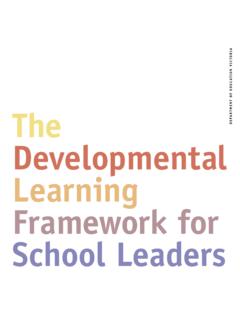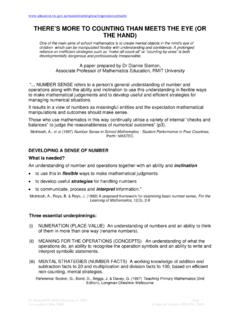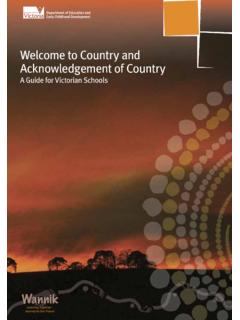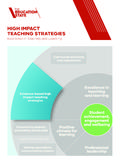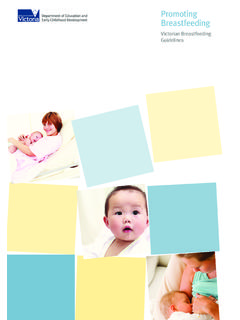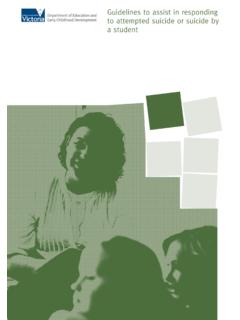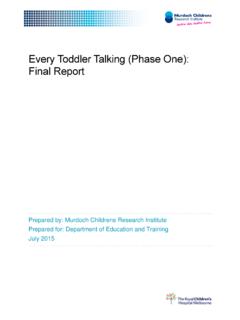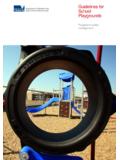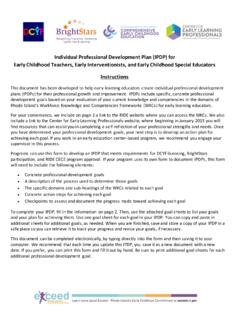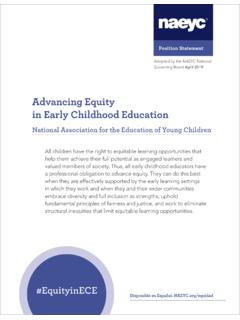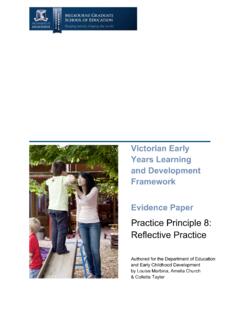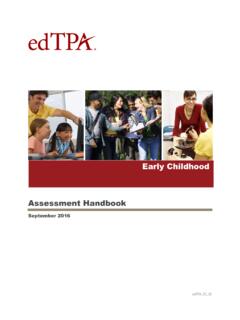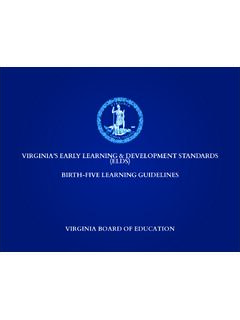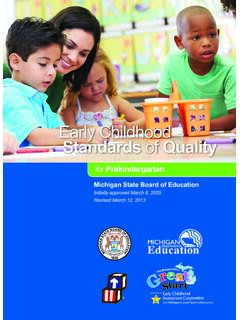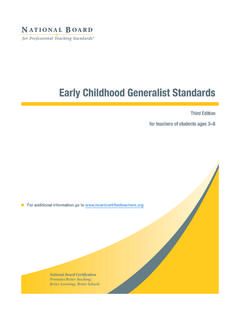Transcription of Collaborative Practice in Victorian Early Years Services
1 Collaborative Practice in Victorian Early Years Services 10 Project Sites Charles Sturt University, 2012 Sandie Wong, Frances Press, Jennifer Sumsion & Louise Hard Page 1 of 42 CONTENTS Acknowledgements .. 2 Acronyms and abbreviations .. 3 Summary Observations .. 4 1. Introduction .. 6 2. Policy Context .. 7 3. Literature Review .. 8 What is Collaborative Practice ? .. 8 Drivers and Enablers of Collaborative Practice .. 8 What are the benefits? .. 9 How do we know it works? .. 10 4. Observations .. 13 Drivers of Collaborative Practice .. 13 Responding to need .. 13 Improving service delivery .. 14 Enablers of Collaborative Practice .. 16 Leadership and Communication .. 16 Relational Agency .. 19 Structure and Process.
2 21 5. Evaluating Collaborative Practice .. 25 6. Conclusions .. 28 7. Site Profiles .. 30 8. References .. 40 Page 2 of 42 ACKNOWLEDGEMENTS The research team was led by Dr Sandie Wong, Dr Frances Press, Professor Jennifer Sumsion and Associate Professor Louise Hard. The authors wish to thank the Victorian Department of Education and Early childhood development for the opportunity to undertake the Collaborative Practice Project, for the support provided throughout the duration of the project, and for the editorial guidance in the final stages. Special thanks, too, to research team members Associate Professor June Wangmann and CSU adjuncts, Dr Joy Goodfellow, Dr Anne Kennedy and Anne Stonehouse for their expertise and collective insights.
3 Charles Sturt University's Research Institute for Professional Practice , Learning and Education (RIPPLE) provided valuable assistance. Above all, thanks go to the participating sites and especially to the staff, families and management who shared their experiences of successful collaboration and of the learning involved. Without their generous contributions, the project would not have been possible. The ten project sites were: BCFC bestchance Child Family Care and bestchance Training, City of Monash, City of Greater Dandenong, Whitehorse CFS Carlton Family Support Service, Western metropolitan EACH EACH Social and Community Health, Maroondah and Yarra Ranges KECIS Kalparrin Early childhood Intervention Service, Northern metropolitan LSEY Linking Schools and Early Years , Hastings, Mornington Peninsula MHLP Moe Heights Literacy Project, Latrobe, Moe MVACK Murray Valley Aboriginal Co-Operative Kindergarten, Robinvale MVCC, FCS Moonee Valley City Council, Family and Children s Services NDP Nathalia and District Preschool, North-West Victoria SMECC Sunraysia Mallee Ethnic Communities Council, Harmony Playgroup.
4 Mildura See Section 7 Site Profiles for more details about each project site, their structure, program and Services offered. Page 3 of 42 ACRONYMS AND ABBREVIATIONS AEDI Australian Early development Index ARACY Australian Research Alliance for Children and Youth CCCH Centre for Community Child Health CSU Charles Sturt University DEECD Department of Education and Early childhood development ECIS Early childhood Intervention Service NQF National Quality Framework MEYP Municipal Early Years Plan VEYLDF Victorian Early Years Learning and development Framework Page 4 of 42 SUMMARY OBSERVATIONS The following is an overview of some of the points raised in the literature on Collaborative practices and observations formed from the project sites.
5 In essence, it speaks of some of the key characteristics of Collaborative Practice , what drives and enables Collaborative Practice , some challenges that may be faced and finally the benefits to children, families, Services , practitioners and the community. Characteristics of Collaborative Practice can be summarised as follows: Collaboration is a deliberate activity. In itself, it is not the goal the outcomes that occur because of collaboration are most important. Collaboration should be transformational, responsive to community needs and guided by clear goals, values and mission to bring people together in common purpose. Effective collaboration requires purpose, structure and processes time, formal agreements, appropriately qualified and/or skilled staff and planning.
6 Paradoxically, it also requires flexibility capacity for staff and Services to make the most of incidental opportunities. Movement towards Collaborative Practice is largely goal driven, philosophically grounded, theoretically informed. There are multiple drivers of Collaborative Practice , and these can be themed in two ways: responding to needs (local community, family, child, data, policy context); and service improvement (financial viability, sustainability, enhancing individual service provision by connecting Services (particularly in small communities with limited Services ), working more efficiently and effectively). Enablers of Collaborative Practice can be summarised as follows: Leadership, both positional and distributed.
7 Qualified staff that know and use research. Professional development and reflection. Effective management of processes, procedures and funding sources. Deliberate recruitment practices that make it clear for applicants that working in a Collaborative way is expected and supported. Time to build and maintain collaboration. Congruent policy initiatives at local, state, national and international levels that facilitate and act as reference points for collaboration. Purposeful use of existing community resources and spaces actively using libraries, sites within schools and Early childhood programs. A focus on good quality relationships, mutual respect, trust and effective communication. Co-location can afford frequency of staff contact and build staff trust.
8 Requirement that staff live the ethos and values in day to day Practice leadership itself is not sufficient for sustainability. Relational agency the strong and sustaining relationships that provide a platform for ongoing and new Collaborative endeavours. Challenges A lack of resources for Services to formally evaluate their work. The blurring of professional boundaries resulting in diminished perceptions of specialist expertise and professional identity and difficulties for staff in recognising the limits of their own disciplinary expertise. Opening up professional approaches to scrutiny by other professionals. Page 5 of 42 Implicit and explicit differences in status between different disciplines that result in the Collaborative agenda being driven by one framework.
9 Funding arrangements may not facilitate Collaborative Practice . Building strong Collaborative Practice takes time and structures that enable dialogue, build relationships and renegotiate new ways of working with professionals. The benefits of Collaborative Practice extend to a number of audiences: Children and Families Reduced family stress due to professionals knowing the whole child within context of their family and needs, support provided by Collaborative professionals, needless multiple reporting, reduced feelings of isolation, children having greater scope for social inclusion, and increased parenting confidence and capacity. Efficient and timely identification of issues, subsequent referrals and fewer cases of children falling through the cracks.
10 Access to a range of Services through soft-entry points and being able to move simply between Services , as well as smoother, more informed transition from Early childhood Services to school. Early childhood professionals High levels of professional development , the opportunity to gain knowledge, learn new skills and advance their professional standing leading to greater job satisfaction. Increased leadership opportunities and capacity to lead and articulate their Practice to families and other professionals. Increased ability to provide referral pathways, collegiate support etc with confidence that leads to the satisfaction of contributing to effective service delivery. Increased opportunity to work collaboratively with school-based educators to assist knowledge transfer and transition processes.
